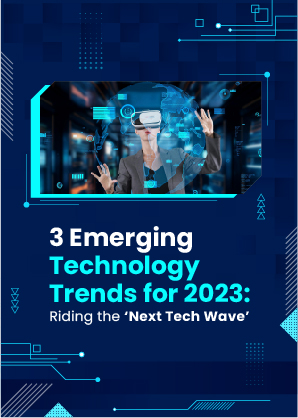or call: +1 (845) 347-8894

or call: +1 (845) 347-8894
or call: +1 (845) 347-8894

In an era where technology evolves at an unprecedented pace, staying ahead of the curve is essential for individuals and businesses alike. Consequently, the year 2023 brings with it a wave of new possibilities, as emerging technologies promise to reshape the way we live and work. To this end, in this blog, we’ll delve into the top 3 emerging technology trends for 2023, exploring what they are, how they are currently utilized, and their potential impact on the future.
Emerging technologies are innovative solutions, tools, and advancements that have the potential to disrupt and revolutionize various industries. Furthermore, these technologies are characterized by their novelty and the promise of significant societal and economic impact. In fact, they often represent the cutting edge of scientific and technological progress.
The importance of emerging technologies lies in their ability to drive progress, efficiency, and innovation. Furthermore, they have the power to improve our quality of life, enhance productivity, and create new opportunities for businesses. Therefore, staying informed about these technologies is crucial for individuals and organizations seeking to adapt and thrive in a rapidly changing world.
Artificial Intelligence (AI) and Machine Learning (ML) are emerging Technology Trends
Refer to the development of computer systems capable of performing tasks that typically require human intelligence. AI involves the creation of algorithms that can reason, learn, and problem-solve, while ML is a subset of AI that focuses on the development of systems that can learn from data.
AI and ML are currently used in various applications, from virtual personal assistants like Siri and Alexa to predictive analytics in industries like healthcare and finance. They are also revolutionizing autonomous vehicles and improving customer service through chatbots.
The impact of AI and ML will continue to expand, leading to innovations in healthcare, personalized learning, and autonomous systems. They are likely to play a significant role in the future of work and various industries, from manufacturing to entertainment.
Emerging technology trend the Internet of Things (IoT) is a groundbreaking concept that has gained immense traction in recent years. At its core, the IoT refers to the vast network of interconnected devices and objects that have the capability to collect and exchange data. These devices encompass a wide spectrum, ranging from everyday household items like refrigerators and thermostats to complex industrial machinery and sensors embedded in urban infrastructure. Specifically, this diverse array of connected devices comprises the Internet of Things (IoT) ecosystem.
The magic of IoT lies in the ability to infuse these objects with the power of connectivity and data-sharing. Specifically, with the integration of sensors, software, and communication technology, these devices can communicate, gather information, and, in many cases, act autonomously, creating a vast ecosystem of connected and intelligent entities.
The utilization of IoT technology has permeated various sectors, and its applications continue to expand. Here are a few ways in which IoT is currently enhancing our world:
1. Smart Homes:
IoT plays a pivotal role in creating smart homes, where interconnected devices like thermostats, lighting systems, and security cameras can be controlled remotely through smartphone apps. As a result, this leads to energy savings, improved security, and enhanced convenience for homeowners.
2. Healthcare Monitoring:
In the healthcare sector, IoT devices like wearable fitness trackers and medical sensors are revolutionizing patient care. Specifically, these devices provide real-time health data to healthcare professionals and patients, enabling remote monitoring, early disease detection, and personalized treatment plans.
3. Supply Chain Management:
IoT has transformed the way products are manufactured, distributed, and tracked. By embedding sensors in products, manufacturers can monitor their location, condition, and quality in real time. This is invaluable in logistics, helping companies optimize routes, reduce losses, and improve overall supply chain efficiency.
4. Environmental Monitoring:
IoT devices are employed in environmental monitoring systems to collect data on air quality, soil conditions, and water quality. These devices are crucial in assessing and mitigating environmental issues and ensuring sustainable practices.
5. Smart Cities:
Cities are embracing IoT to create smarter and more efficient urban environments. For instance, IoT sensors are embedded in streetlights, parking spaces, and waste management systems to reduce energy consumption, ease traffic congestion, and improve public services.
The IoT is on the cusp of ushering in transformative changes that will have far-reaching implications. Here’s how the IoT is expected to shape the future:
1. Connected and Automated Systems:
The IoT’s continued expansion will lead to increasingly connected and automated systems. This means that machines and devices will work in tandem, communicating with each other to streamline processes, reduce waste, and enhance overall efficiency. As a result, the integration of these technologies will lead to improved productivity and optimization across various industries. In the industrial sector, factories will become smarter, and capable of predictive maintenance and self-optimization.
2. Healthcare Revolution:
The healthcare industry will experience a significant transformation with the IoT. For instance, remote patient monitoring will become standard practice, reducing the burden on healthcare facilities and offering more personalized care. Furthermore, wearable medical devices and health-tracking apps will continue to proliferate, improving the quality of healthcare services.
3. Transportation and Mobility:
IoT will play a pivotal role in the future of transportation. Autonomous vehicles, connected traffic management systems, and intelligent infrastructure will enhance road safety and reduce traffic congestion. Additionally, IoT-enabled logistics will lead to more efficient and environmentally friendly freight transport.
4. Agriculture and Resource Management:
In agriculture, IoT technology will optimize resource management. For instance, sensors in the soil and on crops will provide data on moisture levels, nutrient needs, and pest infestations, allowing for precise and sustainable farming practices. Consequently, this can contribute to increased crop yields and reduced environmental impact.
5. Environmental Sustainability:
IoT sensors will continue to monitor and analyze environmental data, aiding in the management of climate change, pollution control, and conservation efforts. Consequently, by collecting and processing large amounts of data, the IoT can contribute to a better understanding of environmental trends and the development of solutions to address them.
Faster Data Speeds:
5G is one of the most useful Emerging Technology Trend in 2023 , the fifth generation of wireless technology, is more than just an incremental step forward from its predecessors. It represents a monumental leap in mobile communications. The key features of 5G are its capacity to provide faster data speeds, significantly lower latency, and enhanced connectivity.
5G networks promise data speeds that are up to 100 times faster than 4G, making it possible to download high-definition movies in seconds and stream content seamlessly.
Lower Latency:
Latency is the delay between sending and receiving data. With 5G, latency is dramatically reduced to around 1 millisecond, making it almost imperceptible to the human eye. This low latency is crucial for applications that require real-time responses, such as augmented reality and remote surgery.
Greater Connectivity:
5G networks have the potential to connect a massive number of devices simultaneously. This is essential for the Internet of Things (IoT) and smart cities. Moreover, in these environments, billions of devices and sensors communicate with each other and with centralized systems.
5g is one of the top emerging technology trend in 2023. The impact of 5G on the future is nothing short of transformative. Here are some of the ways it will revolutionize the way we connect and interact with technology across various sectors:
1. Enhanced Mobile Experiences:
With faster data speeds and lower latency, mobile apps and services will be more responsive, and content will load almost instantaneously. Streaming, gaming, and virtual experiences will be smoother and more immersive.
2. Augmented and Virtual Reality (AR/VR):
5G will be a game-changer for augmented and virtual reality applications. Moreover, it will enable high-definition, low-latency AR/VR experiences, making it possible to explore virtual worlds, conduct virtual meetings, or play AR-enhanced games with minimal lag.
3. Autonomous Vehicles:
Self-driving cars rely on real-time data for navigation and decision-making. Furthermore, 5G’s low latency and high connectivity will be instrumental in making autonomous vehicles safe and efficient. Specifically, they will communicate with each other and with traffic infrastructure to reduce accidents and improve traffic flow.
4. Remote Surgery:
The healthcare sector will see a major transformation with 5G. Additionally, surgeons will be able to perform remote surgeries with precision, aided by haptic feedback and real-time video streaming. Consequently, this can extend medical expertise to underserved areas and emergency situations.
5. Internet of Things (IoT): Furthermore, 5G will power the expansion of the Internet of Things. For instance, smart cities, smart homes, and industrial IoT applications will rely on 5G’s massive device connectivity and low latency to collect and exchange data for improved efficiency, security, and sustainability.
6. Industry 4.0: Additionally, manufacturing and industrial processes will benefit from 5G by enabling real-time monitoring and control. As a result, it will enhance automation, reduce downtime, and improve supply chain management.
7. Content Delivery: The entertainment industry will capitalize on 5G’s speed and low latency. Specifically, this technology will enable immersive live broadcasts, 4K and 8K streaming, and interactive experiences.
8. Environmental Impact: Moreover, the improved efficiency of 5G networks can have a positive environmental impact. Consequently, reduced energy consumption and resource optimization can contribute to a greener future.
9. Education: Finally, 5G can revolutionize remote learning, making high-quality, real-time education accessible to students all over the world. Consequently, virtual classrooms and interactive educational experiences will be more engaging and effective.
10. Innovation Accelerator:
5G’s capabilities will foster innovation in fields we can’t even imagine yet. Similarly, just as the advent of 4G led to the creation of services like Uber and Airbnb, 5G will pave the way for novel applications and services that will redefine the digital landscape.
In an age where technology advances at an unprecedented pace, it is imperative to keep a keen eye on emerging technology trends that can potentially reshape the world as we know it. The year 2023 promises to usher in a new wave of possibilities, fueled by emerging technologies that hold the potential to redefine the way we live, work, and interact with our surroundings. In this exploration of the top 3 emerging technology trends for 2023, we have delved into what these trends entail, how they are presently harnessed, and the profound influence they may exert on our future.
